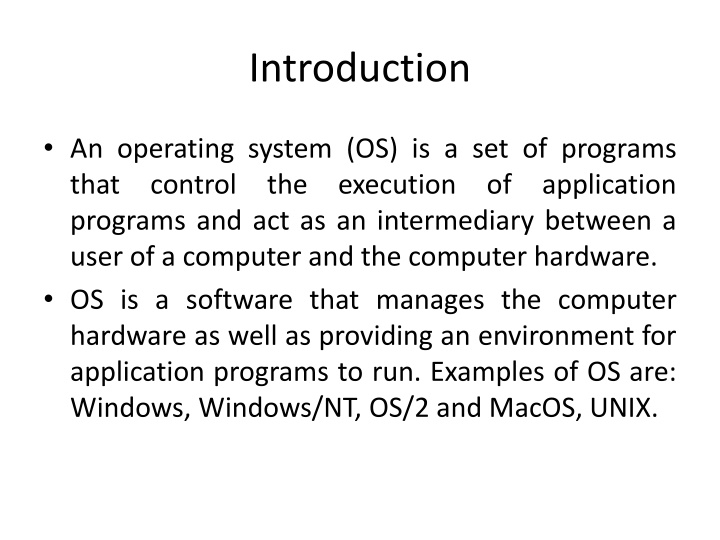
Operating Systems: Components and Terminology
Explore the fundamental concepts of operating systems, including components such as hardware, software, and users, along with key terminology like application programs and system structure. Discover how operating systems facilitate efficient computer use and problem-solving for users.
Download Presentation

Please find below an Image/Link to download the presentation.
The content on the website is provided AS IS for your information and personal use only. It may not be sold, licensed, or shared on other websites without obtaining consent from the author. If you encounter any issues during the download, it is possible that the publisher has removed the file from their server.
You are allowed to download the files provided on this website for personal or commercial use, subject to the condition that they are used lawfully. All files are the property of their respective owners.
The content on the website is provided AS IS for your information and personal use only. It may not be sold, licensed, or shared on other websites without obtaining consent from the author.
E N D
Presentation Transcript
Introduction An operating system (OS) is a set of programs that control the execution programs and act as an intermediary between a user of a computer and the computer hardware. OS is a software that manages the computer hardware as well as providing an environment for application programs to run. Examples of OS are: Windows, Windows/NT, OS/2 and MacOS, UNIX. of application
Introduction The objectives of OS are: (1)To make the computer system convenient and easy to use for the user. (2)To use the computer hardware in an efficient way. (3)To execute user programs and make solving user problems easier
Introduction A computer system can be divided into four components: the hardware, the operating system, the System software & application programs and the users.
Introduction The abstract view of system components is shown in figure 1
Introduction 1. Hardware: CPU, memory and I/O devices. u
Introduction 2. Operating system: provides the means of proper use of the hardware in the operations of the computer system, it is similar to government.
Introduction 3. Application programs: solve the computing problems of the user, such as : compilers, database systems and web browsers. 4. Users: peoples, machine, or other computer.
Basic Concepts and Terminology Computer Hardware Structure Terminology Programming Terminology Operating System Terminology
Programming Terminology Software : the collection of programs or data that are used to perform certain tasks. Program : is a collection of instructions that can be executed by a computer to perform a specific task
Operating System Terminology User : anybody that desires work to be done by a computer. Job : Collection of activities needed to do the work required. Jobs are divided into number of job steps. Job steps: Units of work that must be done sequentially 3 steps: Compile, load, execute Process/task : Computation that may be done concurrently with other computations
Operating System Terminology Address space : the collection of programs and data are accessed in a process forms Two sample address spaces an I/O process , CPU process. Pure Code : code does not modify itself Multiprogramming : Several processes in states of execution
Operating System Terminology Problem State (user state/ slave state) Supervisor State (Master state) Privileged Instruction Protection hardware : to control access to parts of memory Interrupt hardware : to coordinate operations going on simultaneously Interrupt : mechanism by which a processor is forced to take note of an event






















